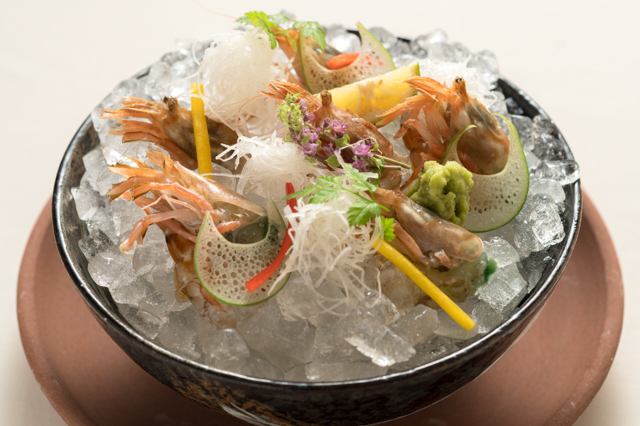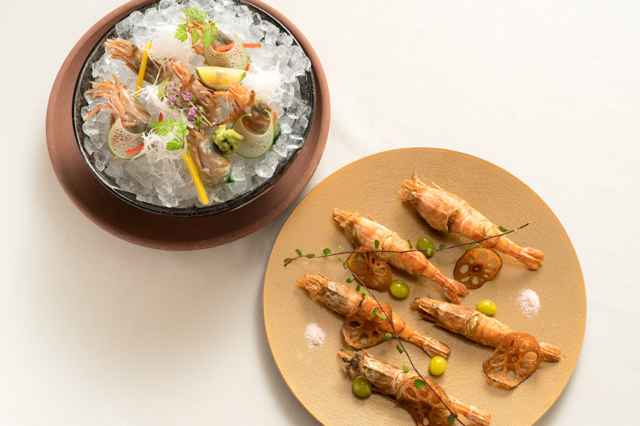Mosaebi no sashimi (Thinly sliced raw fish of Mosa shrimp) | Our Regional Cuisines
-
Tottori Prefecture
Mosaebi no sashimi (Thinly sliced raw fish of Mosa shrimp)
-
Main lore areas
Coastal areas within Tottori Prefecture
-
Main ingredients used
"Mosa Ebi(=Mosa shrimp)"
-
History/origin/related events
The shrimp known as "Mosa Ebi(=Mosa shrimp)" in Tottori Prefecture is formally called "Kurozako Ebi." It is a type of shrimp that can only be caught in the Japan Sea, inhabiting deep-sea areas with a water temperature of around 5°C at depths of 200 to 250 meters. In the Hokuriku region, it is referred to as "Gasu Ebi" or "Doro Ebi," and it has become a well-established ingredient in various regions along the Sea of Japan.
Key production areas within the prefecture include Sakai Fishing Port, Tottori Port, and Ajiro Fishing Port, where it is caught from September to May through offshore bottom trawl fishing. Due to overlapping with crab season, it has become a somewhat hidden gem. Despite its relatively unknown status, it offers a elastic texture, strong "Umami(=savoriness) , and a sweetness surpassing that of sweet shrimp.
"Mosa Ebi(=Mosa shrimp)" is prone to rapid deterioration in freshness, and its head turns black if exposed to air for half a day due to containing copper ions in its blood. Consequently, transportation to distant areas has traditionally been challenging, and it was considered a local delicacy not easily accessible elsewhere. However, currently, albeit in small quantities, it is being shipped alive to areas outside the prefecture. -
Opportunities and times of eating habits
From September to May, "Mosa Ebi(=Mosa shrimp)" is caught using offshore bottom trawl fishing, and it is in its prime during spring when it carries green eggs in its abdomen. Cooking these eggs turns them yellow, and their delightful popping texture adds to the deliciousness. Due to its quick deterioration in freshness, it was said that fishermen used to enjoy it onboard, but nowadays, you can find it served in eateries, inns, and hot spring resorts during the fishing season. It is also available in supermarkets and is cherished as a common household dish.
-
How to eat
For the freshest "Mosa Ebi(=Mosa shrimp)", sashimi is the preferred way to enjoy it. When selecting, look for ones splashing and translucent. After a quick rinse, peel the shell from the body, leaving the head and tail intact, and consume it with sashimi soy sauce. The shells, once peeled for sashimi, can be used to make a rich broth by boiling with added water. This flavorful broth can be used in miso soup and other dishes, allowing people to enjoy the taste twice.
"Mosa Ebi(=Mosa shrimp)" can be prepared in various ways apart from sashimi, including miso soup, simmering, salt-grilling, tempura, and deep-frying. It is also used as an ingredient in "Chawanmushi (=steamed egg custard)." -
Efforts for Preservation and Succession
(Outline of the traditions, the preservation society, social media use, modern approaches to commercialization)
Tottori Prefecture and local tourism associations actively promote information about the deliciousness and recipes of "Mosa Ebi(=Mosa shrimp)" on their websites. In Iwami Town, Tottori Prefecture, the Spring "Mosa Ebi(=Mosa shrimp)" Festival was organized in 2018 as a specialty gourmet event, gathering menus featuring "Mosa Ebi(=Mosa shrimp)". The festival took place at the roadside station(=roadside farmar's market stop), "Kinanse Iwami," sponsored by the local chamber of commerce, among others. Souvenir shops and road stations offer a unique product called "Mosa Ebi Senbei," enclosing the deliciousness of "Mosa Ebi(=Mosa shrimp)" in a rice cracker. This product won an award for excellence in the 2008 "Food Miyako Tottori Prefecture" Specialty Products Contest. Mosaebi are also used in school lunches in Iwami Town.
RECIPE
Ingredients (4)
- "Mosa Ebi(=Mosa shrimp)" 10
- Sashimi soy sauce As needed
- Fresh wasabi As needed
How to cook
-
1. After lightly rinsing, peel the shell, leaving the head and tail.
-
2. Eat it with sashimi soy sauce and fresh wasabi.
Recipes vary depending on the region and home.
Contact
Food Cultures Office, Overseas Market Development and Food Cultures Division, Food Industry Affairs Bureau, Ministry of Agriculture, Forestry and Fisheries
Tel:+81-3-3502-5516







